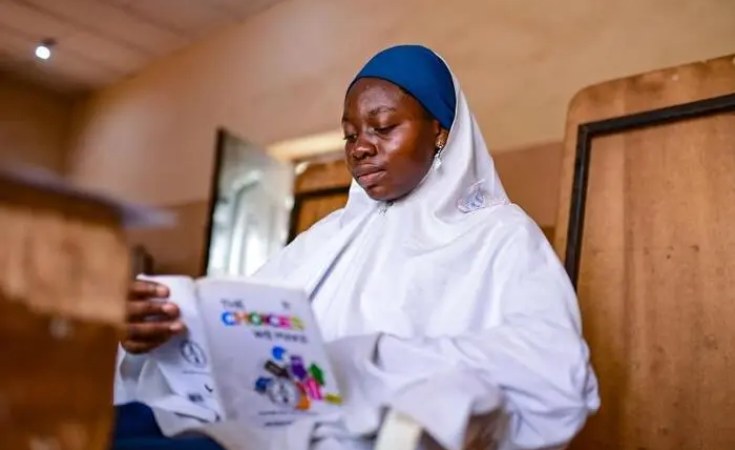The number of girls at extreme risk of facing the double blow of climate change and child marriage is set to increase 33% to nearly 40 million by 2050, new estimates from Save the Children released on the eve of International Day of the Girl reveal.
A new report by Save the Children - "Girls at the centre of the storm: Her planet, her future, her solutions" - also shows that around two-thirds of child marriages happen in regions with higher-than-average climate risks.[1]
Currently an estimated 29.9 million adolescent girls live in the top 10 child marriage-climate hotspot countries[i] , which are the nations that carry the highest risks that a girl will both married as a child and experience life-changing climate disasters.
This figure is projected to increase to 39.9 million by 2050[ii], with these hotspot countries having some of the youngest and fastest growing populations in the world.
The combination of the impact of the climate crisis and child marriage has created emergency hotspots for girls' rights in Bangladesh and across sub-Saharan Africa, where all 10 of the top countries are located. Central African Republic, Chad and Guinea are the worst affected. These countries are not just disproportionately affected by increasingly severe and frequent extreme weather events, but in many cases conflict, high levels of poverty, gender inequality and hunger.
Kpemeh*, in Sierra Leone, was aged 12 when a man expressed his interest in marrying her. As subsistence farmers impacted by the climate crisis, her parents felt financially pressured to agree to the marriage. Supported by Save the Children, Kpemeh was able to avoid the marriage and is now a strong advocate in her community for the rights of girls to finish their education:
"[Child marriage] happens because of poverty. If a man has money, for example if he harvests palm fruits, he can harvest, process and sell it and support the [girl's] family by giving them some palm oil.
"A man expressed interest in marrying me, but I declined. Subsequently, he approached my parents, expressing his desire to marry me. I said I am going to school. Their response was that you have to get married. If the man said he will support you, won't you agree to him?
"The climate has changed and our parents rely on farming. Rain does not fall when it is supposed to fall. It rains in both dry and rainy seasons, it rains when it's not rainy season...and rains when it's dry season."
Climate disasters and the long-term impacts of the climate crisis can increase the risk factors for child marriage, such as being out-of-school, living in poverty, food shortages, being pregnant or having a baby and exposure to other forms of gender-based violence.
Early marriage has devastating consequences for a girl's life. Girls married young are far less likely to stay in school, with lifelong economic impacts. They are often isolated, and they are at higher risk of physical and sexual violence. Child brides are also at greater risk of experiencing dangerous complications in pregnancy and childbirth.
Shruti Agarwal, Senior Adviser: Climate Change and Sustainable Economies at Save the Children said governments, NGOs, the UN and businesses must recognise the climate crisis as an emergency for girls' rights:
"This research shows yet again the extent to which the climate crisis is jeopardising children's rights - particularly the rights of girls.
"The risks to girls are real. It's the risk of sexual harassment and abuse girls face in the chaotic aftermath of a disaster, where overcrowding and lack of safe services leave them exposed. It's being forced to marry before they reach 18, as families are pushed into poverty by years of droughts and forced to make impossible decisions about which mouths to feed.
"The global climate crisis is already changing girls' lives and futures. Yet despite these unequal impacts, less than 2% of national climate plans across the globe mention girls. Less than 4% of climate finance projects give explicit and meaningful consideration to their needs and involvement. Girls demonstrating extraordinary resilience in the face of these challenges, yet their demands and solutions are rarely included in discussions about the planet they will inherit. This is unacceptable.
"Urgent and effective investment is key to adapting to climate change, and is particularly critical for girls who are highly susceptible to the short and long-term impacts. Current spending almost ignores children entirely - this needs to change."
Girls in many of these countries are also now struggling with unprecedented levels of hunger. Across the world, at least 49 million people, including girls and their families are on the brink of starvation, unable to learn and grow because longer-lasting droughts and the war in Ukraine have combined to create a hunger crisis the size and severity of which has not been seen before.v
Save the Children is calling for higher-income countries such as the UK to increase support for lower-income countries who are on the sharp end of the crisis.
You can read the report, Girls at the centre of the storm: Her planet, her future, her solutions, here
NOTES:
[1] On average 80% of children experience at least one extreme climate event (like for example wildfires, crop failures, droughts, floods, heatwaves and cyclones) each year.
[i]Chad, Central African Republic, Bangladesh, Guinea, Burkina Faso, Malawi, Mali, Mozambique, Niger, South Sudan
[ii] Based on UN population prospects
You can read our 2022 report, Generation Hope: 2.4 billion reasons to end the global climate and inequality crisis here.
You can read the 2021 report with the Vrije Universiteit Brussel, Born into the Climate Crisis, here.
Help children affected by the Hunger Crisis - Donate now to our Global Hunger Crisis fund.


